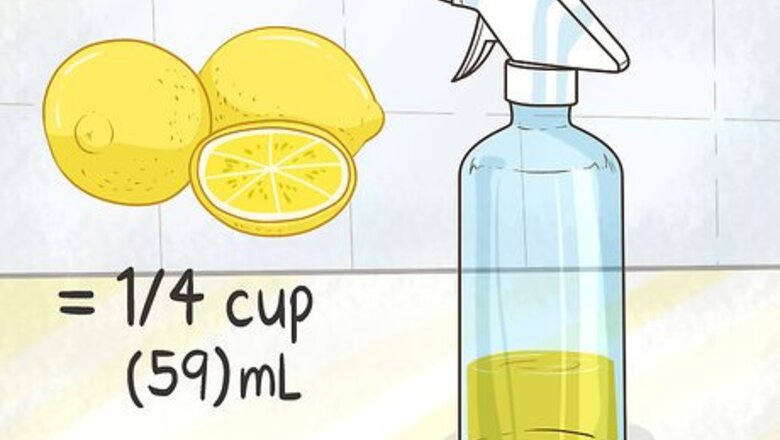
views
Lightening Naturally Blonde Hair with Lemon Juice
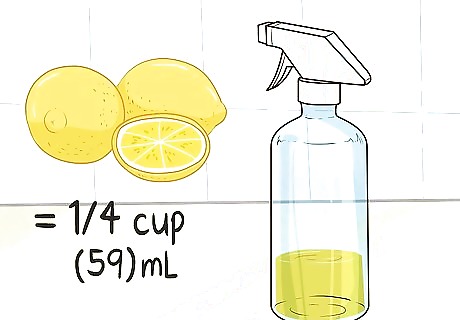
Squeeze the juice from 2 lemons and put it into a spray bottle. Cut 2 lemons in half, then squeeze the juice into a clean measuring cup. Check to see how much lemon juice you squeezed from the lemons by reading the measurement. Then, carefully pour the lemon juice into a spray bottle. 2 lemons generally yield about ⁄4 cup (59 mL) of juice. It’s okay to estimate your ingredients if you don’t want to bother with a measuring cup. If you have a funnel, use it to prevent spilling the lemon juice.
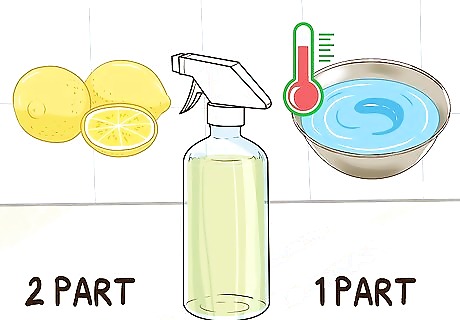
Add warm water to create a 2 part lemon juice-1 part water solution. Divide the amount of lemon juice you used by 2, then measure out that amount of warm water. Carefully pour the water into your spray bottle, then screw on the lid. Shake the bottle to combine your ingredients. For instance, if your lemons yielded ⁄4 cup (59 mL) of juice, then you'd divide that by 2 to get ⁄8 cup (30 mL) of warm water.
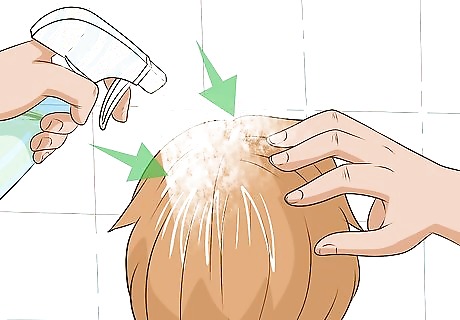
Spray the lemon juice onto your hair. Coat your hair with the lemon juice until it’s damp. Pay special attention to areas that are yellow. Additionally, spray more juice onto your roots than onto your ends. Your ends are more porous, which means they will soak up more lemon juice than your roots will. Put your extra lemon-water into the refrigerator to save for later. Lemon juice will expose the underlying pigments in your hair, which are usually gold or yellow. Lemon juice works best on blonde hair if you’re trying to make it brighter.
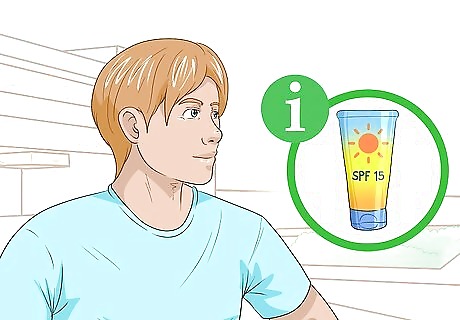
Sit in the sun for at least 1 hour. Try to find a spot where you’re in direct sunlight. Set a timer for 1 hour and relax as the sun lightens your hair. Wear sunscreen to protect your face and exposed skin. Choose an SPF 15 sunblock or higher.Tip: Sit outside for up to 2 hours for best results. However, don't leave the lemon juice on your hair all day, as it might dry out your hair.
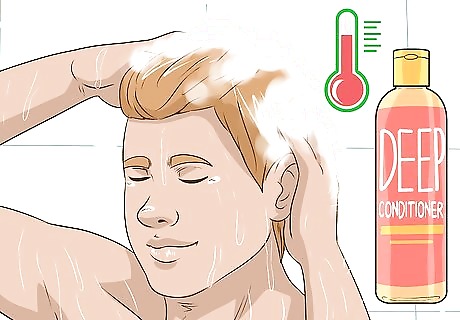
Wash your hair and treat it with a deep conditioner. Wet your hair with warm water, then apply shampoo to remove the lemon juice from your hair. Rinse and apply a deep conditioner to help smooth your hair and repair any dryness. Let the conditioner sit on your hair for about 3 minutes. Then, rinse out the conditioner with cool water. The cool water will seal your hair’s cuticle so that it looks smooth and shiny.
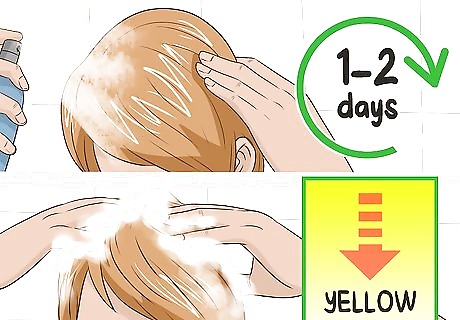
Repeat the treatment every 1-2 days until the yellow is gone. The lemon treatment will only lighten your hair a little at a time. If your hair is only slightly yellow, it might look better after 1 treatment. However, you may need several treatments to see the results you want. Let your hair rest for a day or 2 between treatments. Expect to do about 4 treatments before you see really noticeable results.
Toning with Apple Cider Vinegar
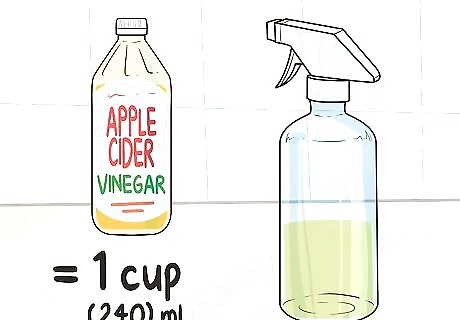
Add 1 cup (240 mL) of apple cider vinegar to a spray bottle. Measure out your apple cider vinegar, then pour it into a spray bottle for easy application. If you don’t want to measure your vinegar, it’s okay to estimate it. You can find apple cider vinegar in the cooking section at your local grocery store. It’s on the same aisle as other types of vinegar. Apple cider vinegar will help lighten hair slightly, but it won’t remove much yellow from your hair.

Coat your hair with the apple cider vinegar. Spray the apple cider vinegar onto your hair, starting at your roots. Slowly work your way down, dampening your entire head of hair with apple cider vinegar. Pay special attention to areas that look yellow. Apply more apple cider vinegar to your roots than to your ends. Because your ends are more porous, they’ll absorb more of the vinegar. It’s best to do this in the shower, especially since you’ll need to rinse it out anyway.Tip: Vinegar has a strong smell, but it should dissipate over time. If it really bothers you, cover it with your favorite hair care products.
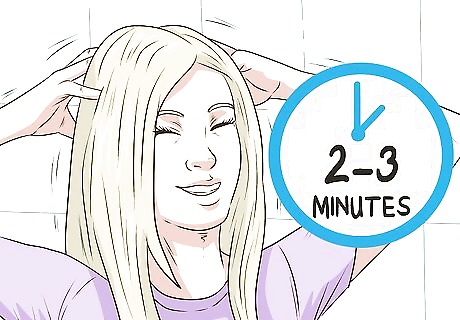
Massage the vinegar into your hair and scalp for 2-3 minutes. Use your fingers to gently massage your hair and scalp, working the vinegar throughout your hair. Continue to massage for 2-3 minutes to allow the vinegar to work. This will ensure that your hair is evenly coated in vinegar. Take this time to relax.
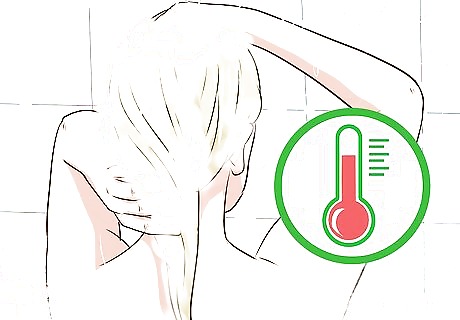
Rinse out the vinegar with warm water. Turn on your shower, then stand under the water to rinse out the vinegar. Stay under the stream of water for at least 1-2 minutes to fully rinse your hair. If you’re not applying conditioner, quickly rinse your hair with cool water before getting out of your shower. This will seal your hair’s cuticle so that your hair looks smooth and shiny.
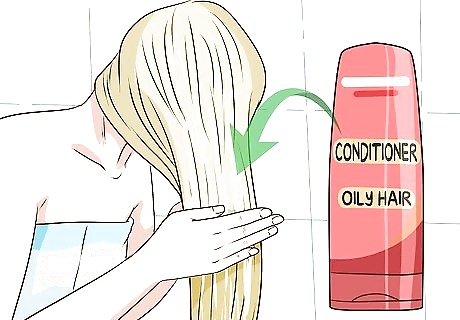
Condition your hair to cover the vinegar smell and smooth your hair. Apply a thin layer of conditioner to your wet hair, using your fingers to work it into your hair evenly. Let the conditioner sit on your hair for about 3 minutes, then rinse it out under cool water. Use a conditioner that’s formulated for your hair type. For instance, if you’ve dyed your hair, choose a color-safe conditioner.
Using Baking Soda and Hydrogen Peroxide
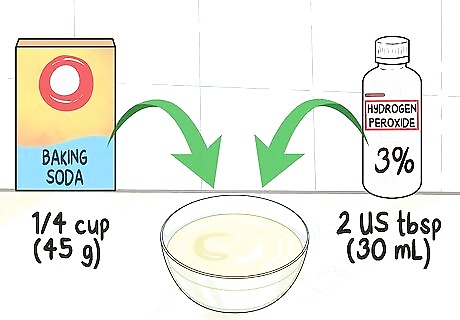
Mix ¼ c (45 g) of baking soda with 2 US tbsp (30 mL) of 3% hydrogen peroxide. Measure out .25 c (45 g) of baking soda and add it to a clean bowl. Then, use a measuring spoon to add about 2 tablespoons (30 mL) of 3% hydrogen peroxide to the bowl. This amount works best for thin, short hair. If you have thick hair that’s longer, you may need to make more product. You will likely notice fizzing and bubbles as the hydrogen peroxide reacts to the baking soda. This is normal, so don't be alarmed. Mix 1 tablespoon (15 ml) of water with 1 tablespoon (15 ml) of hydrogen peroxide to dilute the formula and make it gentler.Warning: Don’t use higher than 3% hydrogen peroxide, as it may damage your hair.
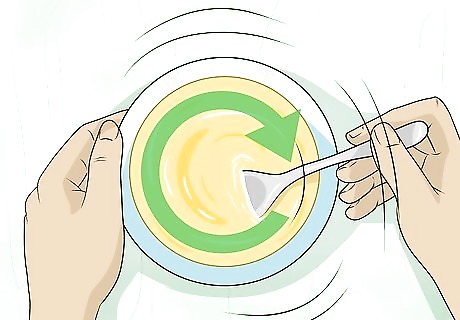
Stir the baking soda and hydrogen peroxide until they make a paste. Use a plastic or wooden spoon to blend the baking soda and hydrogen peroxide into a paste. Keep stirring until the paste is an even consistency. Add more hydrogen peroxide if necessary to make your paste thin enough to spread onto your hair.

Use your fingers or a dye applicator to apply the paste to your hair. Use your fingers or a dye applicator brush to coat your hair with the paste. Make sure you apply an even layer of paste so that you don’t leave any hair untreated. It’s best to wear gloves if you use your fingers. You can find a dye applicator brush at your local beauty supply shop.
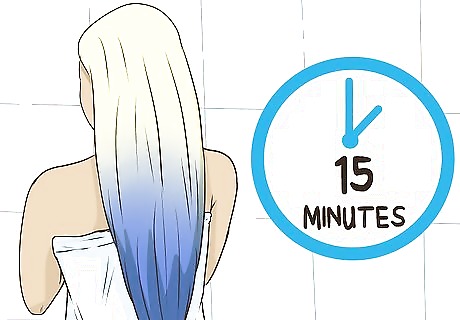
Let the paste sit on your hair for 15 minutes, then rinse with warm water. Set your timer for 15 minutes, then relax while the paste lightens your hair. Next, rinse out the paste with warm water. As you rinse, run your fingers through your hair to help break up the paste. The baking soda and hydrogen peroxide should naturally bleach the yellow out of your hair.
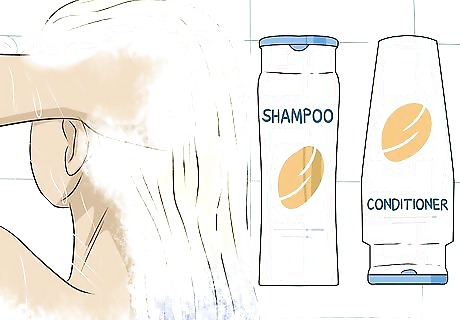
Shampoo and condition your hair using warm water. Pour about a quarter-size amount of shampoo into your hand, then work it into your hair from your roots to the ends. Next, rinse out the shampoo under warm water. Then, apply a thin layer of conditioner to your hair. Let it sit for 3 minutes, then rinse out the conditioner under cool water. The final cool water rinse seals your cuticle so your hair looks soft and shiny. You may want to follow this treatment with an apple cider vinegar rinse for best results.
Preventing Yellowing
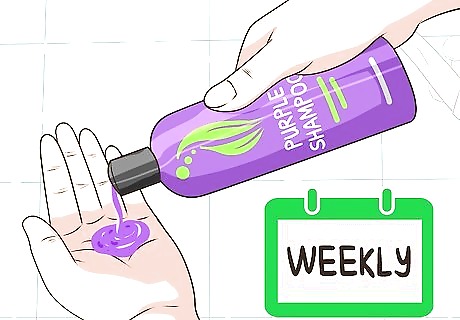
Use a purple shampoo weekly to help tone your hair. Purple shampoo adds tiny deposits of color to your hair to counteract yellow and orange shades. If you use it once a week in place of your normal shampoo, it may keep the yellow out of your hair. Choose a darker purple if you have blond hair or a light violet for silver or white hair. Don’t use your purple shampoo more than once a week unless your stylist tells you to do so. Using it too often can turn your hair light purple or make it look muddy.Variation: If you only wash your hair 1-3 times per week, use your purple shampoo once every other week. You don’t want to use it very often.

Wash with a clarifying shampoo once a month. Your water can deposit minerals on your hair, which may react to the heat of your curling iron which can turn your hair yellow. Hair can also change due to smoking, pollution, or product buildup. Wash your hair once a month with a clarifying shampoo to prevent this buildup so your hair won’t turn yellow. You can use any brand of clarifying shampoo, but look for 1 that’s labeled as “Daily Clarifying” or “Deep Cleansing.”

Apply a heat protectant to prevent heat tools from burning your hair. Unfortunately, heat damage can make blond, grey, or white hair turn yellow. Since the hair is damaged, you can’t remove the discoloration without cutting your hair. However, this is fairly easy to prevent with a heat protectant. Always spray your hair with a heat protectant before blow drying, straightening, or curling your hair. Look for a product that’s labeled for your hair type, such as color-treated hair. Many thermal protectants have added SPF, which can help protect your hair from the sun as well.
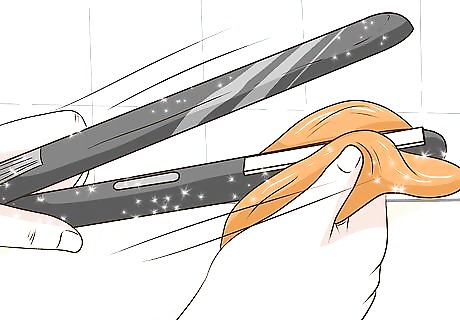
Make sure your heat tools are clean before you use them. Dirty heat tools can leave unwanted deposits on your hair or may accidentally burn your hair. Check your tools before each use to make sure they’re clean. Additionally, wipe your tools with a face cloth once a week to keep them clean. You can clean your styling tools using a damp face cloth. After unplugging your styling tool, wait until it’s cooled to warm, then wipe it down with the cloth.
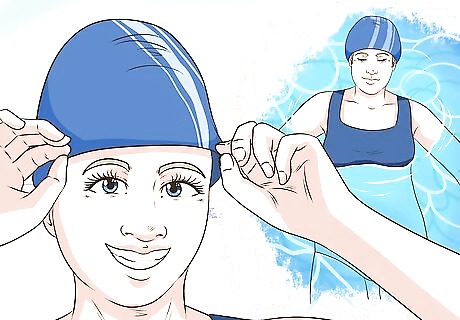
Wear a swim cap while swimming to protect your hair from chlorine. You likely know that chlorine can damage your hair, but it can also turn it yellow. You can protect your hair from yellowing by always wearing a swim cap while you’re in the pool. You can find a swim cap online. If you don’t want to wear a swim cap, then rinse your hair and apply a conditioner to it before getting in the pool. The conditioner makes a protective barrier and stops chlorine absorption.Variation: After swimming without a swim cap, wash your hair immediately after you leave the pool with a clarifying shampoo. Then, apply your favorite conditioner, let it sit for 3 minutes, and rinse with cool water.



















Comments
0 comment